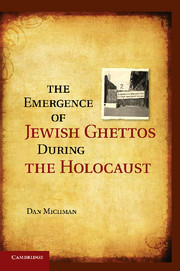Crossref Citations
This Book has been
cited by the following publications. This list is generated based on data provided by Crossref.
2011.
Foundational Pasts.
p.
153.
Wünschmann, Kim
Kobrynskyy, Oleksandr
Peschel, Lisa
Rice, Monika
and
Sturdy Colls, Caroline
2013.
Book Reviews.
Holocaust Studies,
Vol. 19,
Issue. 2,
p.
127.
Michman, Dan
2014.
‘The Holocaust’ – Do We Agree What We Are Talking About?.
Holocaust Studies,
Vol. 20,
Issue. 1-2,
p.
117.
2014.
Le peuplement comme politiques.
p.
359.
Cole, Tim
2015.
Revisiting Holocaust Representation in the Post-Witness Era.
p.
93.
Møller, Bjørn
2015.
Refugees, Prisoners and Camps.
p.
35.
Kassow, Samuel
2017.
The Cambridge History of Judaism.
Hájková, Anna
and
von der Heydt, Maria
2017.
Biedermeier desk in Seattle: the Veit Simon children, class and the transnational in Holocaust history.
European Review of History: Revue européenne d'histoire,
Vol. 24,
Issue. 5,
p.
732.
2019.
Holocaust in Norwegen.
p.
767.
Katz, Steven T.
2019.
The Holocaust and New World Slavery.
Kaparulin, Yurii
2020.
ХРОНІКА ХЕРСОНСЬКОГО ГЕТТО (1941 р.).
City History, Culture, Society,
p.
88.
Stone, Lewi
He, Daihai
Lehnstaedt, Stephan
and
Artzy-Randrup, Yael
2020.
Extraordinary curtailment of massive typhus epidemic in the Warsaw Ghetto.
Science Advances,
Vol. 6,
Issue. 30,
Miron, Guy
2020.
A Companion to the Holocaust.
p.
247.
Molina, Ana Heloisa
and
Ragusa, Helena
2020.
Os novos contornos do antissemitismo, a construção de imaginários pela mídia no Brasil e a escrita da História.
Sæculum – Revista de História,
Vol. 25,
Issue. 43,
p.
361.
Smallman-Raynor, Matthew R.
and
Cliff, Andrew D.
2020.
Theresienstadt: A Geographical Picture of Transports, Demography, and Communicable Disease in a Jewish Camp-Ghetto, 1941–45.
Social Science History,
Vol. 44,
Issue. 4,
p.
615.
Schwartz, Daniel B.
2021.
Key Concepts in the Study of Antisemitism.
p.
121.
Topor, Lev
2021.
The Covert War: From BDS to De-legitimization to Antisemitism.
Israel Affairs,
Vol. 27,
Issue. 1,
p.
166.
Walch, Teresa
2021.
Theresienstadt – Filmfragmente und Zeitzeugenberichte.
p.
21.
Liao, Kaihuai
Lv, Peiyi
Wei, Shixiang
and
Fu, Tianlan
2022.
A Scientometric Review of Residential Segregation Research: A CiteSpace-Based Visualization.
Sustainability,
Vol. 15,
Issue. 1,
p.
448.
Walch, Teresa
2024.
Theresienstadt: Film Fragments and Testimonies.
p.
21.



